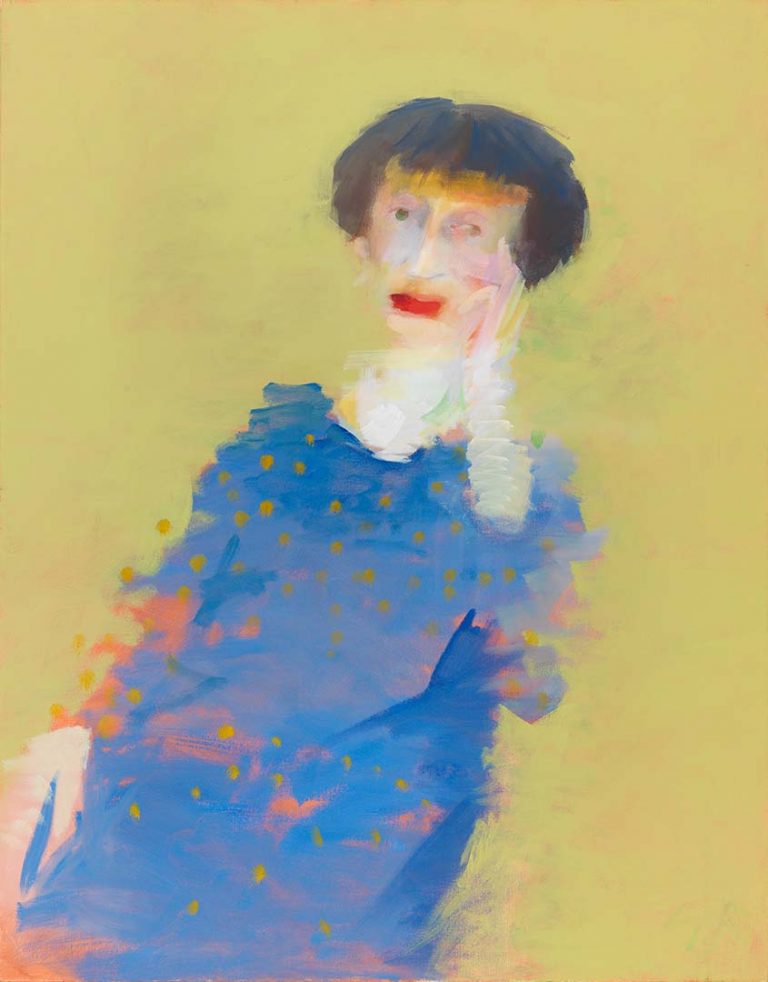We acknowledge the Traditional Owners of the land on which the Queensland Art Gallery | Gallery of Modern Art stands and recognise the creative contribution First Australians make to the art and culture of this country.

Sam Fullbrook / Australia 1922–2004 / Ernestine Hill 1970 / Oil on canvas / 96.8 x 76.3cm / Gift of the artist 1972 / Collection: Queensland Art Gallery | Gallery of Modern Art / © QAGOMA
Sam FullbrookErnestine Hill 1970
Not Currently on Display
This painting of Brisbane-born novelist Ernestine Hill (1899–1972), commissioned by her son, Robert, was a finalist in the 1970 Archibald Prize.
Sam Fullbrook had great affection for Hill, whom he saw as the embodiment of an earlier age. Their friendship, which developed while they were both living in Buderim, was based on a shared history of life on the land and a deep appreciation of the Australian bush.
Hill’s three-quarter figure seems to float upwards, an image of dignity and frailty — more spirit than substance. Her blue dress, blurred and soft-edged, bleeds into the background. Tiers of white, hatched brushmarks suggest the ruffled cuffs or gloves of an earlier time (though Hill claimed she never wore gloves). The softness of the body contrasts with the strength of the sitter’s bright red lips, dark hair and introspective gaze.
One of Australia’s most influential postwar painters, Sam Fullbrook was a highly skilled colourist and tonalist, often described as a painter’s painter. At 15, he worked as an itinerant bush labourer before enlisting and serving overseas during World War Two.
Fullbrook’s artistic career began on his return to Australia, when he attended the National Gallery of Victoria Art School in Melbourne. He regularly attended life-drawing classes, a practice he strongly advocated throughout his life.
Travelling all over Australia, and living at various times in Queensland — in Brisbane, Buderim, and the Darling Downs near Oakey — Fullbrook worked in the traditional genres of landscape, portraiture, and flower painting, recording the people and places that impressed him.
Sam Fullbrook won the Wynne Prize for landscape painting in 1963 and 1964, and the Archibald Prize for portraiture in 1974. Despite being a great portraitist, he was never fashionable as one, because his paintings were often seen as lacking the detail expected in a realistic portrait.
Discussion Questions
1. Portraits have been painted by artists throughout history. Discuss why artists paint portraits and why people would want to have their portrait painted.
2. Ernestine Hill was an Australian journalist, travel writer and novelist. This portrait of her tells the viewer much more about the subject than what she looks like. Which of Ernestine Hill’s personal qualities are brought to the viewers’ attention in Fullbrook’s rendition?
Classroom Activities
1. Think about a person you would like to paint. What would it be helpful to know about your subject? Before making their portrait, gather some material about the person you have chosen. Explain your choice to a classmate. Using your research material as a starting point, paint a portrait which includes clues to your subject’s story through their clothing, jewellery and the background you choose. Write a short statement explaining the choices you made.
2. Think about how to best depict a friend of yours by placing emphasis on the personal qualities that you admire about them. The physical qualities are obviously important, but the challenge of the exercise is to find ways to capture a sense of who they are, rather than recording a purely physical resemblance. Capture these qualities in a portrait.